|
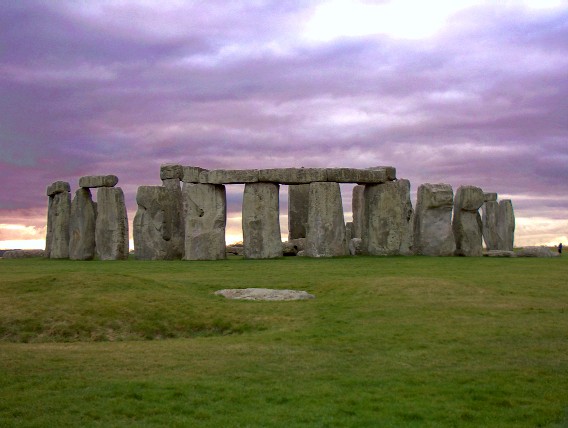 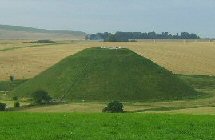 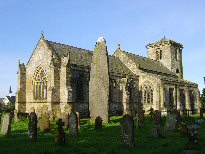 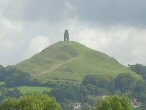 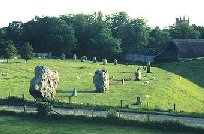
 Prehistoric England:
(Albion)
Prehistoric England:
(Albion)
The English landscape is
rich with a huge variety of megalithic constructions, many of which are unique
to the
British Isles, such as Henges, Recumbent Stone Circles (RSC's), and
Cursus, to name a few.
It is also home to
thousands of standing-stones, stone-circles, 'tumuli', alignments (Around 60 stone rows around Dartmoor alone),
long-barrows, dolmen (Quoit's),
holy-wells, beacon-hills, ley-lines and sacred/ceremonial landscapes.
At around 6,000 BC Britain
become an island, separating from the European mainland.
|
This abundance of
megaliths on the English landscape, the traditions, folk-lore and myths weave together
to form one of
the richest prehistoric tapestries in the world.
|
Prehistoric England - Featured Items: |
|
Henges.
(There are
about 100 Henges in Britain and Ireland, dating from 3,200 BC).
(1)
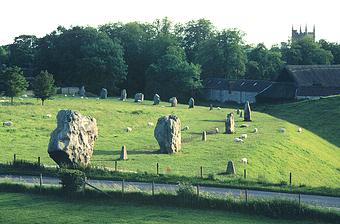 Henge-structures are now known to
have begun being built before stone circles. Their construction would
have involved thousands of man hours. (i.e. Stennes
in Scotland was estimated at 12,500 man hours alone)
(1), as in most cases they were
built on levelled areas and included huge ditches and banks reaching
several metres in depth and height. Henge-structures are now known to
have begun being built before stone circles. Their construction would
have involved thousands of man hours. (i.e. Stennes
in Scotland was estimated at 12,500 man hours alone)
(1), as in most cases they were
built on levelled areas and included huge ditches and banks reaching
several metres in depth and height.
In many cases Henges occur in doubles
or triples, and astronomical orientations and alignments have been shown
suggesting a primary Astro-ritualistic or scientific function.
(More about Henges) |
|
The Silbury/Avebury Complex:
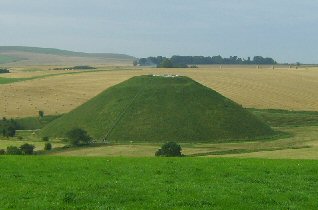 (Silbury Hill,
Stonehenge,
Avebury, Old Sarum). (Silbury Hill,
Stonehenge,
Avebury, Old Sarum).
The location
of Silbury hill, (Avebury) on Latitude
51� 24� 50�� N
is considered by many to be evidence of a deliberate geodetic placement.
Not only is
this latitude of Silbury the same as the exterior of Menkaure's pyramid at
Giza, but the latitude of Giza is also the same as the exterior angle
of Silbury Hill.
(More about Silbury
Hill)
|
|
Stone Circles:
(The British
Isles contain over 1,000 ancient circles made of stone, wood or soil).
 Although Stone circles are found in many
other countries around the world, their frequency, diversity and sheer
size in the British Isles is not repeated anywhere else in the world.
England contains both the largest stone circle in the world at
Avebury, and the most expensive at
Stonehenge. Although Stone circles are found in many
other countries around the world, their frequency, diversity and sheer
size in the British Isles is not repeated anywhere else in the world.
England contains both the largest stone circle in the world at
Avebury, and the most expensive at
Stonehenge.
Although several stone circles are now known
to have have had an astronomical relevance, it is not necessarily the case
that they all did. It was shown by John Michell, for example, that many English stone circles have a geometric
relationship, and a funerary association can be seen in the frequent
(often secondary) deposits of human remains found at stone circles across
Britain.
(Click
here for more about Stone circles)
|
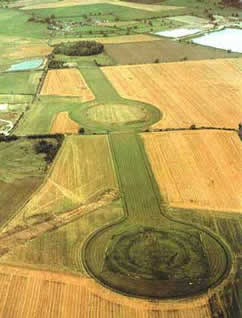 Thornborough Complex:
(The Stonehenge of the North) Thornborough Complex:
(The Stonehenge of the North)
The megalithic constructions around Thornborough have traditionally been
seen as a cluster of disassociated, individual entities, but today we are
starting to see them again as part of a larger, connected sacred landscape
with the three Thornborough Henges in the centre. This site has been
described by English Heritage as 'The most important site between
Stonehenge and the Orkneys', and served as a prehistoric ceremonial site from
3,500 BC to 2,500 BC.
It can be seen at Thornborough
that the three Henges were built over an already existing mile-long Cursus,
a fact which supports both the theory that Cursus came before Henges, and
that the two different forms may share a similar function (namely the
creation of an artificial horizon in an enclosed space).
The three Henges mirror 'Orion 's belt', a feature seen at several other
ancient sites around the world.
(More
about the Thornborough Complex)
(Orion Worship in Prehistory)
|
|
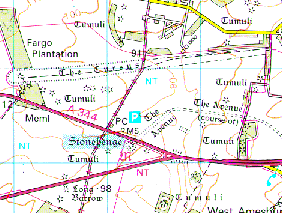 Cursus (Cursii). Cursus (Cursii).
Cursus' are
one of the
earliest forms of major earthworks identified in the British Isles.
The Cursus
is a prehistoric landscape feature which appears to have been particular to
Britain and while most are found in England, there are also a few suspected
in Ireland. The scale of construction suggests an organised or even civil level
of construction, requiring
hundreds, if not thousands of man-hours for each site.
At
Stonehenge, there are two cursus, the larger of which has recently been
dated by Manchester University at 3,500 BC which makes it older than the
first construction phase of Stonehenge itself.
(2)
(More about Cursus)
|
|
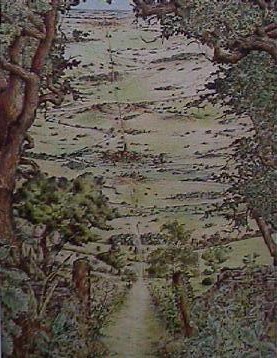 Ley Lines. Ley Lines.
Ley-lines are by no means exclusive to
England, but it was one of the first European countries to have recognised the tradition of placing ancient and sacred constructions in
alignments, (which were named
ley-lines
by Alfred Watkins). The most famous
significant discovery in this field was by John Michell, who identified the
St.
Michael's Ley - a
'corridor of incidence' running across the country in an alignment that
followed the line of the sun on the May-day sunrise.
Connecting ancient and sacred sites with straight
lines common practice in England for thousands of years. While some have
been shown to have a primary astronomical orientation, others are
associated with funerary rituals and others appear to have been purely
geometric.
(More about Ley-lines)
|
|
 White Horse Hills. White Horse Hills.
There
are/were around 24 white horses in Britain, with the majority of them
etched into the chalk cliffs in Wiltshire. While some are only a few
hundred years old, the tradition can be shown to go back three thousand
years.
The
Uffingdon White Horse - The oldest white horse in Britain, the
figure has been shown to date back some 3,000 years based on optically
stimulated luminescence dating carried out following archaeological
investigations in 1994 by Oxford university. These studies produced
three dates ranging between 1400 and 600 BC.
Local tradition claims the Uffington horse to be a representation of the dragon
slain by St. George. |
Article: ScienceDaily (Dec. 15,
2008).
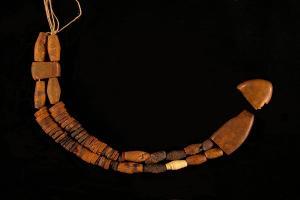 A
4,000-year-old amber necklace has been unearthed in England. The rare
find was unearthed from a stone-lined grave � known as a Cist -
excavated by the team from The University of Manchester Field
Archaeology Centre and Mellor Archaeological Trust. A
4,000-year-old amber necklace has been unearthed in England. The rare
find was unearthed from a stone-lined grave � known as a Cist -
excavated by the team from The University of Manchester Field
Archaeology Centre and Mellor Archaeological Trust.
It is the first time a necklace of
this kind from the early Bronze Age has been found in north west
England.
Peter Noble from The University of
Manchester said: �An amber necklace of this sort was one of the most
important ways that people of the early Bronze Age could display
their power and influence.
�The fact that it has been found in the
north west of England is pretty amazing and extremely rare.�
Dozens of different sized pierced
amber beads are linked together on a length of fibre to form the
beautiful artifact. It was discovered by Vicky Nash from of the Mellor
Archaeological Trust.
Peter Noble, who directed the dig
added: �The necklace was made of amber � which is not found in this
region.
�In fact, the nearest source is in the
Baltic so we�re bound to ask, how did it get here and who brought it?�
(Ref:
http://www.sciencedaily.com)
|
English Landscape Geometry: |
There
are now several examples of geometry between some of the most
significant prehistoric megaliths in England, apparently connecting the
landscape in a way first envisioned by William Stuckeley.
The late
Prof. Alexander Thom recognised such a geometric fingerprint in
megaliths ranging across all of western Europe, but only within the
dimensions of the structures themselves, not
between
structures.
Although this subject is
largely disregarded by mainstream, it should not be ignored, as
discoveries such as the Great Decagon are
supported by the earliest scriptures in England. The right-angled
triangle formed by Stonehenge, Glastonbury, and Arbor Low(below, left) suggests an origin of this
practice originating around 3,000 BC.
It is important to note that these
divisions are all by units of degrees.
 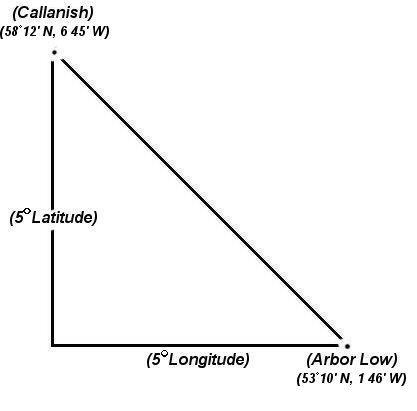
(More about English Geodesy)
|
List and Description of Featured English Sites: |
|
Name. |
Description. |
|
Adam's Grave. |
Long Barrow on the Ridgeway. |
|
Arbor Low. |
Derbyshire, Stone circle, Henge, Cove. |
| Avebury. |
Wiltshire, The Largest
Stone circle in the World |
|
Boscawen-un. |
Cornwall,
19-stone Stone Circle. |
|
Castlerigg. |
Cumbria, Stone Circle. |
|
Cerne Abbas Giant. |
Dorset, Chalk Cut Giant on Hill-side. |
|
Devil's Arrows |
Alignment of 3 menhirs towards
Thornborough. |
|
Dorchester Big Rings. |
Cursus and Henge monument on the St. Michaels leyline. |
|
Dorset
Cursus |
Two Cursus end to end 6.5miles long. |
|
Dragon
Hill |
Ancient White Horse, Henge, Earthworks. |
|
Glastonbury |
The 'Sacred Heart' of
England |
|
The Hurlers |
Cornwall,
Three Stone Circles. |
|
Knowlton. |
Christianised Henge complex. |
|
Men-an-Tol |
Cornwall, Four Stones, One 'Holed'. Remains of Stone circle. |
|
The Merry Maidens |
Cornwall, Stone Circle. |
|
Nine
Maidens |
Another name for the Boscawen-Un stone circle. |
|
Old Sarum. |
Important Hillfort, Original location of Salisbury. |
|
Rollright's. |
Oxfordshire. Stone circle, Standing stone,
Long-barrow. |
|
Rudstone |
Largest standing stone in Britain. |
|
Sanctuary, The |
Concentric Stone circles, Part of Avebury
complex. |
|
Silbury Hill |
Wiltshire, The largest ancient structure in Europe. |
|
Stanton Drew |
Avon, Three Stone Circles, Two avenues and a Cove. |
|
Stonehenge |
Wiltshire, The most
expensive Stone-Circle in the World. |
|
Thornborough
Complex |
Three Henges, Cursus, Sacred landscape. |
|
Trethevy
Quoit |
Large Dolmen near the Hurlers. |
|
Waulud's
Bank. |
Henge structure on the St. Michaels ley and the
Icknield Way |
|
Waylands Smithy |
Long Barrow on the
Ridgeway. |
|
West Kennet |
Oldest 'Long Barrow' in
England. |
|








 Ley Lines.
Ley Lines. White Horse Hills.
White Horse Hills. A
4,000-year-old amber necklace has been unearthed in England. The rare
find was unearthed from a stone-lined grave � known as a Cist -
excavated by the team from The University of Manchester Field
Archaeology Centre and Mellor Archaeological Trust.
A
4,000-year-old amber necklace has been unearthed in England. The rare
find was unearthed from a stone-lined grave � known as a Cist -
excavated by the team from The University of Manchester Field
Archaeology Centre and Mellor Archaeological Trust.
